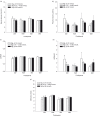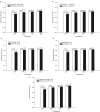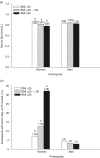Lower serum magnesium concentration is associated with diabetes, insulin resistance, and obesity in South Asian and white Canadian women but not men
- PMID: 25947295
- PMCID: PMC4422846
- DOI: 10.3402/fnr.v59.25974
Lower serum magnesium concentration is associated with diabetes, insulin resistance, and obesity in South Asian and white Canadian women but not men
Abstract
Background: A large proportion of adults in North America are not meeting recommended intakes for magnesium (Mg). Women and people of South Asian race may be at higher risk for Mg deficiency because of lower Mg intakes relative to requirements and increased susceptibility to diabetes, respectively.
Objective: This study compared serum Mg concentrations in South Asian (n=276) and white (n=315) Canadian women and men aged 20-79 years living in Canada's Capital Region and examined the relationship with diabetes, glucose control, insulin resistance, and body mass index.
Results: Serum Mg concentration was lower in women of both races and South Asians of both genders. Racial differences in serum Mg were not significant after controlling for use of diabetes medication. A substantial proportion of South Asian (18%) and white (9%) women had serum Mg <0.75 mmol/L indicating hypomagnesemia. Use of diabetes medication and indicators of poorer glucose control, insulin resistance, and obesity were associated with lower serum Mg in women, but not in men.
Conclusions: These results suggest that the higher incidence of diabetes in South Asians increases their risk for Mg deficiency and that health conditions that increase Mg requirements have a greater effect on Mg status in women than men.
Keywords: McAuley's index; adults; body mass index; glucose; homeostatic model assessment of insulin resistance; magnesium status; quantitative insulin sensitivity check index.
Figures





References
-
- Paolisso G, Scheen A, D'Onofrio F, Lefebvre P. Magnesium and glucose homeostasis. Diabetologia. 1990;33:511–14. - PubMed
-
- Kao WH, Folsom AR, Nieto FJ, Mo JP, Watson RL, Brancati FL. Serum and dietary magnesium and the risk for type 2 diabetes mellitus: The atherosclerosis risk in communities study. Arch Intern Med. 1999;159:2151–9. - PubMed
-
- Rumawas ME, McKeown NM, Rogers G, Meigs JB, Wilson PW, Jacques PF. Magnesium intake is related to improved insulin homeostasis in the Framingham offspring cohort. J Am Coll Nutr. 2006;25:486–92. - PubMed
-
- Huerta MG, Roemmich JN, Kington ML, Bovbjerg VE, Weltman AL, Holmes VF, et al. Magnesium deficiency is associated with insulin resistance in obese children. Diabetes Care. 2005;28:1175–81. - PubMed
LinkOut - more resources
Full Text Sources
Other Literature Sources

